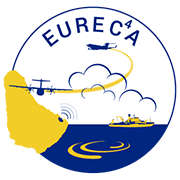21 Jan
To those who pay attention to the subject headings; we skipped forward in time by nine years … Anyway, today I am on my own today (at least as far as developing this post is concerned) and thought to toss out an idea that some people might have input on.
In today's Worldview image you can, with a bit of imagination, see wave like crests transverse to what I imagine as a strong trade wind flow. This sort of pattern is common, and even more pronounced looking back a couple of days, as seen here in the attached image from the 19th of January. Often you see these types of cross flow banded features in what I perceive to be regions of strengthened trade-winds, like are developing now as the storm moves off the East coast of the US. This sort of patterning is also evident in our global cloud resolving modelling, as seen about midway through this video:
These bands often form the broader context for many of our favorite forms of mesoscale organization of shallow convection. Are they waves, and if so what causes them? Is it an internal dynamics related to clouds, or simply features in the momentum field? Chris Bretherton and Peter Blossey have been thinking about the mesoscale organization of shallow convection and make the case for a convective heating feedback … https://agupubs.onlinelibrary.wiley.com/doi/10.1002/2017MS000981 Sandrine and her group, and also some nice work by Ann Kristin Naumann looking at radiatively driven pressure gradients, raises the question as to the role of radiative coupling, following a similar vein.
 Maybe, but in this case I can’t help but also think of waves forming on water running over inclined pavement, like in the attached image from Physics Stack Exchange. These sorts of waves are called ‘Roll Waves’ … which I think are like a series of bores. They develop if the flow moves faster than the gravity wave speed; the latter goes as the layer depth, so the waves work best if the layer is shallow and the wind (or current) is strong. Here I think of the gravity waves being on the shallow frictional boundary layer.** The counter argument could be that they are not as singular in the wave front as a sequence of bores might be expected to be.
Maybe, but in this case I can’t help but also think of waves forming on water running over inclined pavement, like in the attached image from Physics Stack Exchange. These sorts of waves are called ‘Roll Waves’ … which I think are like a series of bores. They develop if the flow moves faster than the gravity wave speed; the latter goes as the layer depth, so the waves work best if the layer is shallow and the wind (or current) is strong. Here I think of the gravity waves being on the shallow frictional boundary layer.** The counter argument could be that they are not as singular in the wave front as a sequence of bores might be expected to be.
The theory for roll waves (1D shallow water with friction), which I am not expert on, were sketched out by Harald Jeffries 94 years ago. So I was wondering, if you watch the imagery, if you see these as often as I do. If so does anyone know the literature describing them? I guess it would be easy to test whether they are more likely to form at a critical velocity, or stability (which will control the depth of the layer. In any case they nicely imprint themselves on the cloud field … whether the cloud field imprints back is another question — maybe something for EUREC4A.
Cheers, Bjorn
** Chris B and I were having this discussion once, and I can’t remember if he was making the same point, but I thought we were disagreeing, but maybe I was just expressing myself poorly.
